July 15th, 2014 §
You’d be forgiven for thinking the name of this blog should be Bugs, Birds and Buck Mountain. Posting has been heavy on the natural history lately, I suppose because I want to keep a record of the creatures that share this land with me. That, and baby birds are just cool.
But fear not—there is still some farming happening at Bonafide Farm, and as it’s been months since the last vegetable garden update that’s what we’ll do today.

I will be the first to admit that I am not in love with this garden this year, for several reasons. First, when I planted it in April I was pretty sure I would be moving away from the farm at the end of summer and didn’t think too seriously about where I put things. Second, the overwintered greens took up a vast amount of valuable real estate, and though I enjoyed them as we emerged from winter we had a long, cool spring and I didn’t get to pull them out to use their space for something else until just now, when it’s really too hot and dry to get much going. Finally, my veg garden is just too small, and plants are packed too tightly for all of them to get the sunlight they need to thrive. I hate working around them when they are so thick, always worrying about brushing against a wheel bug or hidden wasp nest.
I haven’t yet expanded the garden because that requires another goat rope of getting huge posts, pounding them in, digging in chicken wire around the perimeter, etc., not to mention beginning to improve the soil by shoveling tractor buckets of compost, all of which is doable but after having spent four painful months and thousands of dollars on a rotator cuff injury this winter I am leery of straining my still-fragile shoulder.
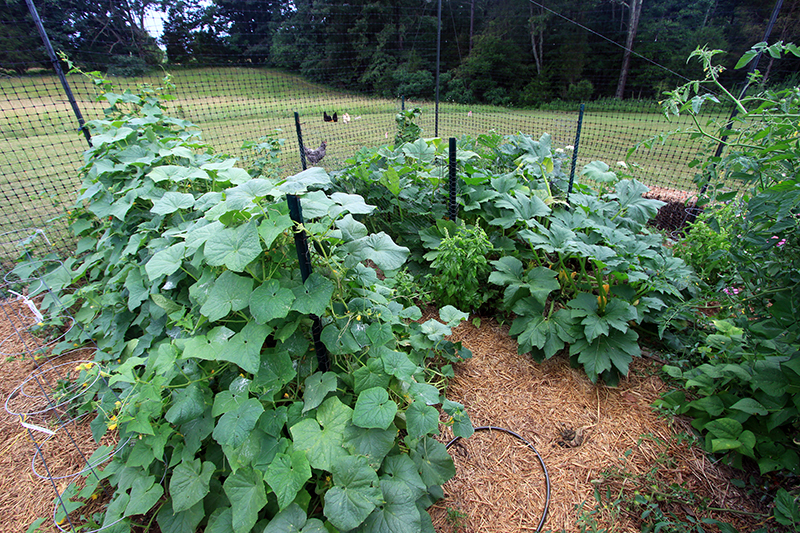
So, the garden is what it is. It’s not the most organized or pretty but it’s putting out vegetables and flowers and that’s all I suppose it really has to do. There have been some surprises this season. The most notable is that my squash, which usually falls victim to squash bugs around the time it’s ready to harvest, is chugging along just fine. It’s in the photo above, to the right of the massive cucumber installation. I don’t know if the polar vortex is behind this lower squash bug population this year, or if it has to do with moving the squash to a new location in the garden. I do know that for the first time ever I am using an “organic” pyrethrin dust, which I applied when the plants were young and every so often now. I don’t think that’s entirely the reason, though, as it’s a contact insecticide, not really a repellant, and I just haven’t seen much evidence of squash bugs or their eggs. Of course I may be totally jinxing myself by even writing this. The irony is I planted the squash in amongst other things, anticipating that it would be dead by now and the other plants could take over. But that’s not how it’s turning out, and I suppose I shouldn’t be complaining about something living instead of dying!

Again I am overrun with cucumbers. I think it’s because when you buy little two-leafed cuke seedlings they come about eight to a pot so it’s easy to overplant. Nobody needs this many cucumbers. But again, like with the squash, I expected these plants to have fallen to the cucumber beetles by now and they haven’t. The chickens are getting a lot of cucumbers.
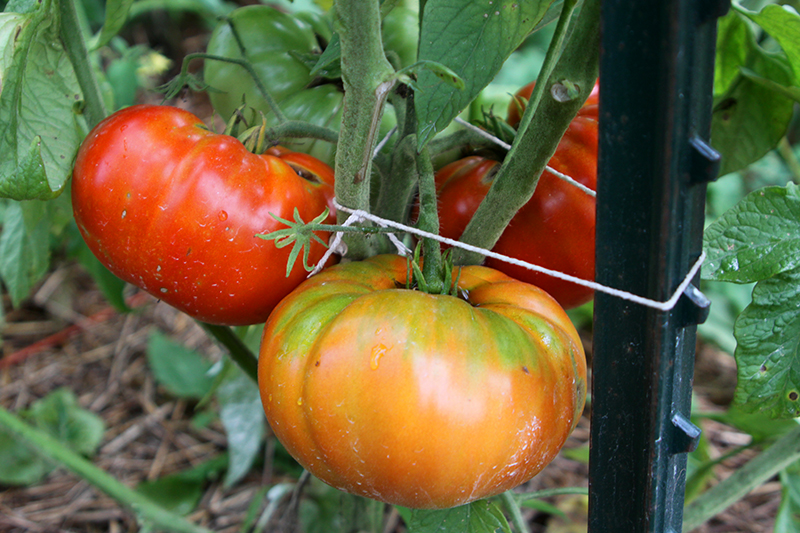
The tomatoes are all now mostly taller than I, and I am trying a new technique with them in that I did not pinch off any suckers. All my life I was of the “pinch the suckers” school of tomato growing, but this year I thought I’d let them go and see what happened. What happened was massive plants that I tried to tie up last night, which required full-body hugging the plants as I collected each vine near the post. I guess tomatoes need love too. Even planted on generous 36″ centers, the plants are growing together making harvest hard. But I did pick my first big tomatoes last night, with “Early Girl” for the win, and others are right behind. That’s “Brandywine” above, nice and big. The plants are gorgeous and healthy, with just the tiniest bit of manageable fungus-related yellowing near the base.
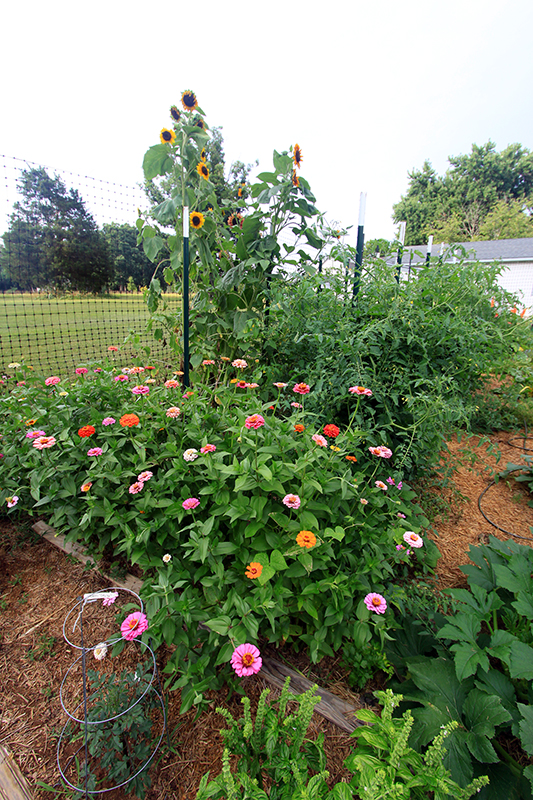
I have a few rows of cutting flowers—zinnias and cosmos, and some volunteer gladiolus that I tried to dig out this spring but obviously I didn’t manage to get all the bulbs. There are lots of surprises that germinated from years’ past and I just let go, such as random green beans, unidentified greens, the sunflowers above, and a very mysterious white squash rambling through the cosmos. Like I said, kind of a mess.

But here we are, mid-July, and this is what I have to work with. The summer is going so fast that I know it will be only a few more weeks before everything goes round the bend and starts its late-summer decline.
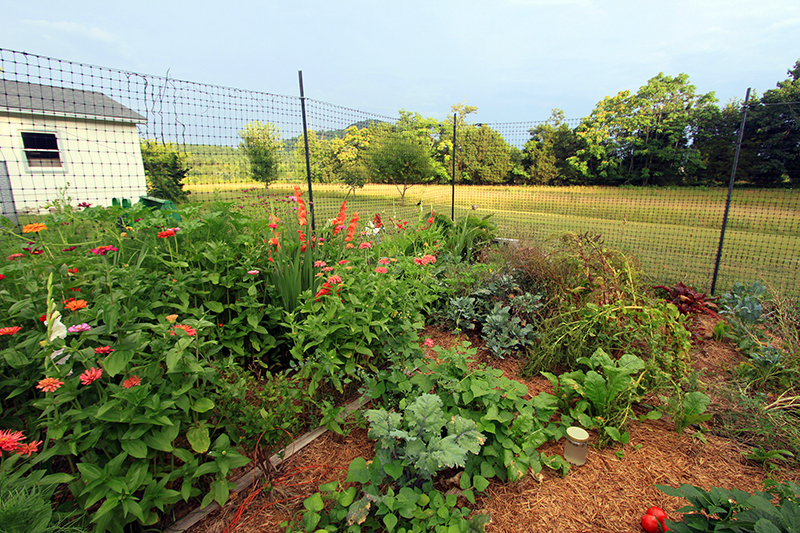
And the nice thing about gardening is that each year you get a do-over. Maybe this fall I will get the garden expanded and then have fresh land to cultivate next year. I really want to put in a ton of perennial fruits and vegetables that need space to mature, such as berry bushes, asparagus, rhubarb, and strawberries, so that’s a good incentive to get out the dreaded t-post driver.

July 8th, 2014 §
The Japanese beetles have been the pest of the summer thus far, way worse this year than the previous three. They’re munching my rhubarb, my hops, and most distressingly to me, my zinnias—one of the few plants I grow that’s usually trouble-free.

Twice a day I make the rounds, knocking the shiny beetles into a jar of soapy water. I’ve got quite a collection now, a real dead bug sun tea that I am considering dumping all over the zinnias as a repellant. But I suppose I don’t want my cut flowers smelling like the black magic in that jar.
When I was a kid, maybe 10 or 11, my grandfather paid my brother and me to go around the yard knocking Japanese beetles into metal coffee cans full of diesel fuel. The going rate was a penny a beetle, and yes, settlement was delivered only after we dumped the cans out onto the gravel driveway and picked through the dead bugs, counting. I can still feel the sensation of sorting those prickly-footed beetles, slick with stinky fuel that clung to my fingers. A penny a piece doesn’t sound like much, but the beetles were thick that year and I made about $20, which at that time was the most money I’d ever earned.
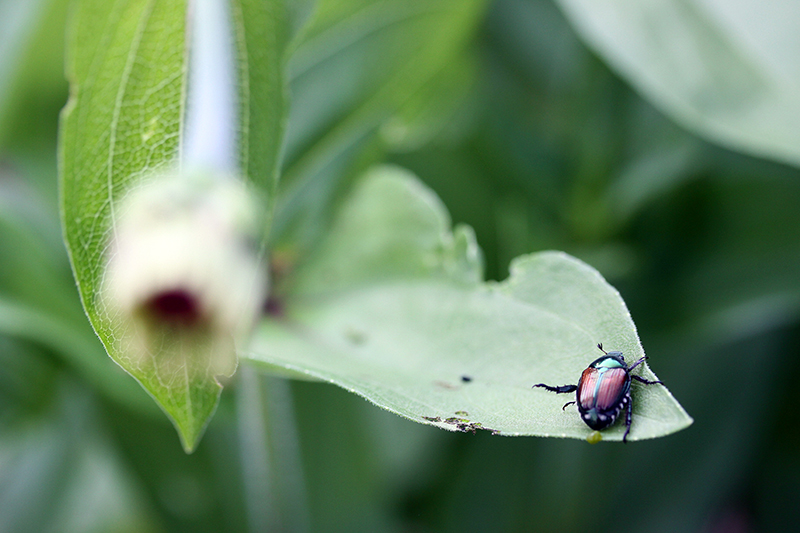
Who would have thought that twenty-five years later I’d be walking around my own garden, knocking beetles to their deaths? Though I guess now we’re a bit more enlightened about pest control and chemical exposure and know that diesel fuel belongs in the tractor, not in my beetle jar. Still, the method is the same.
June 26th, 2014 §
This is the first harvest of summer 2014—a few squash and zucchini that managed to outrun the oncoming squash bugs, some hot peppers, basil and other herbs, and five Sun Sugar tomatoes. Tomatoes before the fourth of July—not bad considering our long, cold spring.

The zinnias are just coming on, and I bet tomorrow I will see the first cosmos bloom. It is great to be back in the cutting flower business. From now until frost there will be homegrown bouquets all around my house. 
Such bounty calls for a celebration with fire. As I didn’t do much for the Solstice this past weekend, I fired up the grill to cook a first harvest/Solstice feast as thunder bounced around the mountains. I just got the grill a few weeks ago, a gift from my mom, and it’s been a steep learning curve to understand this entirely new way of cooking. It’s a good challenge, and one I needed as my culinary selfeducation had grown stagnant. It feels wonderful to push myself, to make mistakes, have “eureka” moments and accidental epiphanies, and at the end of it all, if I’m lucky, dinner.

And what a dinner it was. Garlic shrimp, my veg, some corn slathered with butter and seasonings and wrapped back up in its husk to grill. A simple, perfect salsa made with my five pretty gold tomatoes, basil, salt, pepper and olive oil. These squash were on a whole other level from the pallid supermarket varieties I grilled last week. Call me a tree-hugging hippie, but I can taste a difference when I eat something I planted in April as a two-leafed seedling, nurtured and protected, and finally harvested within twenty minutes of consuming. Vegetables taste alive, almost meat-like in their nutrition and vitality. They go straight to my brain.
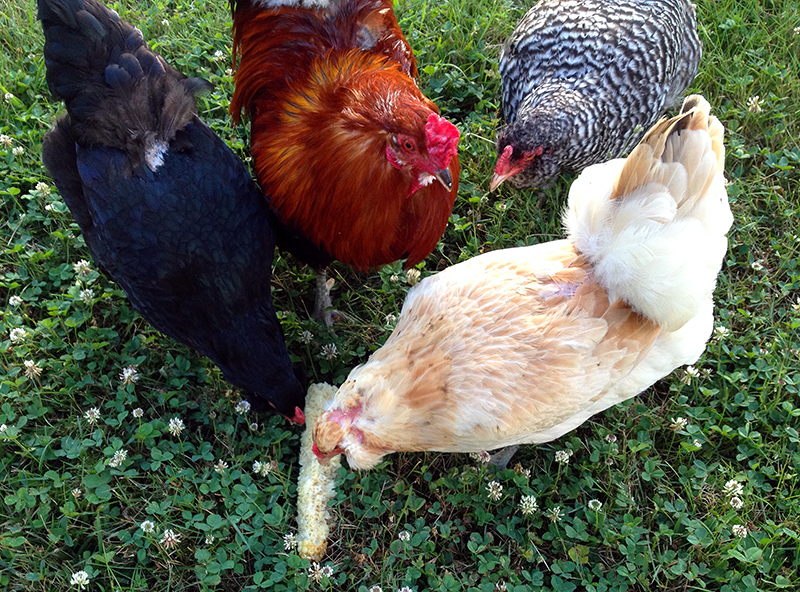
And, nothing is wasted.
June 24th, 2014 §
All things considered, last winter’s polar vortex left Bonafide Farm relatively unscathed. I lost a few plants, including some huge rosemary bushes, a new lilac, and a handful of perennials. My ‘Pat Austin’ rose died back by half but returned with new canes, only a bit misshapen. But my fig tree was another story entirely.
Figs are considered to be tender trees in this climate, even in non polar vortex winters, and only survive if planted in warm, sheltered locations. Knowing this I planted mine, a cultivar called ‘Celeste,’ on the south side of the big white garage wall, where it would bake in the summer and enjoy wind protection and reflected heat in the winter. 
It seemed to be doing well, and after three or four years in the ground, last year it attained about six feet in height and was really starting to crop. I was pretty happy I got a fig to grow here. This year, however, I waited and waited for signs of life from it. April passed, and May crept on. The bare grey branches showed no sign of budding, and I started to lose hope and began planning to replace my fig.

But then in early June I saw tiny green buds sprouting from the fig’s base. Halleluiah! I held off on cutting back the dead branches until it became clear that the tree was in full rejuvenation mode, coming back from the ground, and all its old wood was dead. Then out came the saw and pruners and I dismantled several years of growth to make way for the new sprouts.
As the heat’s turned on the fig has taken off, lush and thick with growth that’s now about two feet tall. It will probably be another three years until it bears fruit again, but I am just so happy to have not lost the tree that I can wait.
And speaking of waiting, let me tell you a story about a fig that waited fifteen years to find a home at Bonafide Farm.
I went to college in Tucson, Arizona, and when I was either nineteen or twenty I moved into an old stucco duplex south of campus. I was told that the home was built around 1900 by German immigrants who were hired to build the railroad through Tucson. Each German family brought cuttings of their fig trees from back home and planted them in their new country. I had one such fig tree in my backyard, and it took up most of the lot. It was huge, probably 15 feet tall and wider than that, thick with gnarly grey branches that bore copious green figs. Here’s the only photo I could find, which I scanned, looking at the back of the house through the fig branches, which are just leafing out:

Knowing nothing about tree propagation, I took cuttings from this fig and stuck them in coffee cans of soil on my porch. Amazingly, they rooted. I got two small trees growing, which I potted up into successively larger pots…and then proceeded to cart around the country for the next fifteen years. The trees went with me to San Diego, and while I was living in DC they lived at my parents’ house, where my mom made sure they didn’t die. Four years ago the trees came to live here, but I still didn’t plant them in the ground because I was afraid they wouldn’t be able to take the winter and would die. So they stayed in their pots, where I had essentially turned them into bonsai by limiting their growth, and they produced a few pale figs in the summer. Each winter I stored them in the wellhouse.
Well, this spring when I pulled them out they weren’t looking so hot, which I understood as it got cold enough to freeze the pipes in the wellhouse last winter. The figs’ branches were dry and shriveled, and I couldn’t sense a heartbeat from either tree. Still, I stuck them in the sun and watered them, and waited, growing more forlorn as the weeks passed with no signs of life. I was very sad to lose trees that had such history, and mad at myself for not planting them in the ground earlier (which I am learning is a pattern of mine, and one to be changed), even though there’s no guarantee they would have fared better there.
But then last week I looked at one of the trees and saw the palest shade of green on one of the branches. Could it be? Was it still alive?

Wasting no time—this time—I dug a hole right next to my other fig (for botanical companionship and moral support), and planted my Tucson fig. I watered it in well, and put up a chicken wire fence to protect it from the dog. Within three days the green bud burst into a tiny leaf, and other green buds appeared. Now, after just a week in the ground, the fig is leafing out.

And there’s the story of the redemption of the figs, and how new old trees grow at Bonafide Farm.

June 14th, 2014 §
Meadows are hot right now, with horticulturalists’ renewed focus on habitat preservation/creation and the rise of the “new perennial” gardening movement that showcases native and “wild-looking” plants in naturalistic compositions. Everyone loves a meadow—or at least the image of them as presented in aspirational garden porn—billowing fields of lively grasses punctuated with bright yellow, pink and white blooms that persist all summer long. 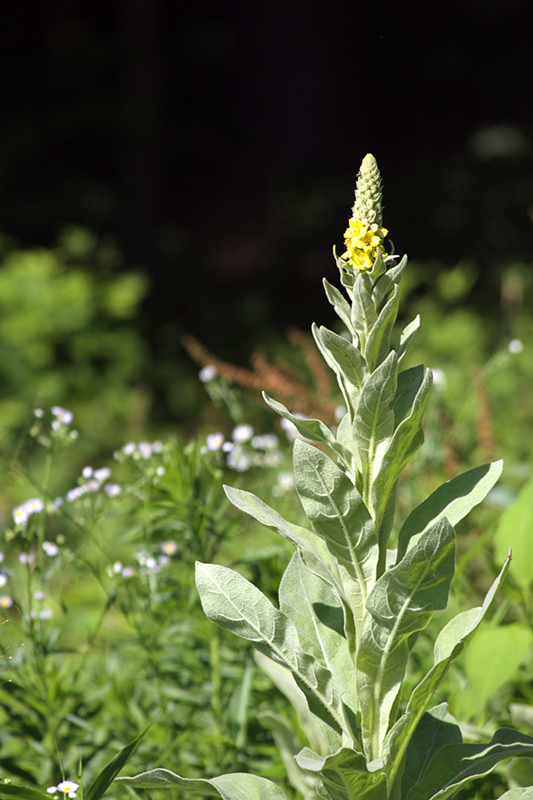
There are several ways to achieve the cultivated meadow look, and the most commonly accepted, and perhaps effective, method involves several rounds of herbicide spray that kill all existing plants back to bare dirt, a process that takes about a year in order to catch each wave of germination. The idea is to create a blank slate so that you may then, ideally in the fall, sow a mix of wildflower seeds that’s usually composed of annuals, to give you quick, first-year color, and perennials, which will take longer to get going but persist and multiply through the years. Without leveling the playing field with herbicide, the desired wildflower seeds most likely wouldn’t be able to germinate and out-compete the existing vegetation.
All this is fine, and I’ve seen some lovely meadows created this way. But the idea of mass herbicide spray doesn’t sit well with me, nor does watching vast swaths of ground turn brown and shrivel, taking with it the native plants in all their diversity only to be replaced with a select blend of imports. As much as I would love to try creating a wildflower meadow, and still may, I haven’t yet been able to reconcile the steps I’d have to take to get there.

But as I was mulling this gardener’s quandary, a wildflower meadow was quietly forming right in my own yard with almost no help from me. It happened in the transitional zone between the forest and my mowed field, on a patch of ground that had been thickly colonized by invasive alanthus trees, honeysuckle, and brambles. This area was cleared back to bare dirt two winters ago, and I basically just left it alone.
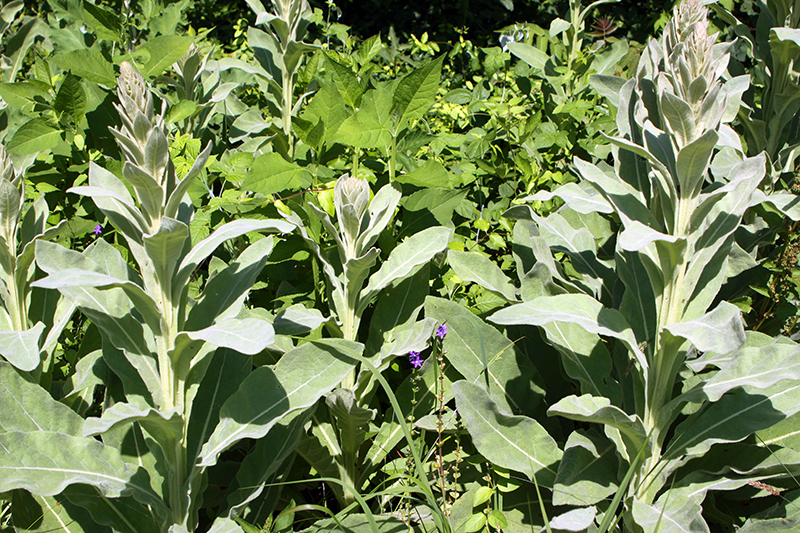
Last year I noticed tons of mullein plants sprouting in the bare dirt. Mullein are the pioneers of the plant world—they are among the first plants to recolonize disturbed ground. They are biennials, and in their first year form a rosette of soft, fuzzy grey-green leaves. The second year the plants shoot tall yellow flower stalks high into the sky. Mullein has a long and respected heritage in herbal medicine, and is commonly used to treat disorders of the respiratory system. If you believe in the doctrine of signatures, the leaves of mullein are lung-shaped, which indicates that they are beneficial to that part of the body.
I think mullein are incredibly beautiful, and so I refrained from mowing them last year in order to see them bloom this year. Well, in not mowing this patch of ground, I unintentionally created what has turned out to be a fascinating wildflower meadow—no herbicide needed. In addition to purple clover, wild strawberries, and countless other plants, here are just a few of the flowers I’ve identified in my meadow:
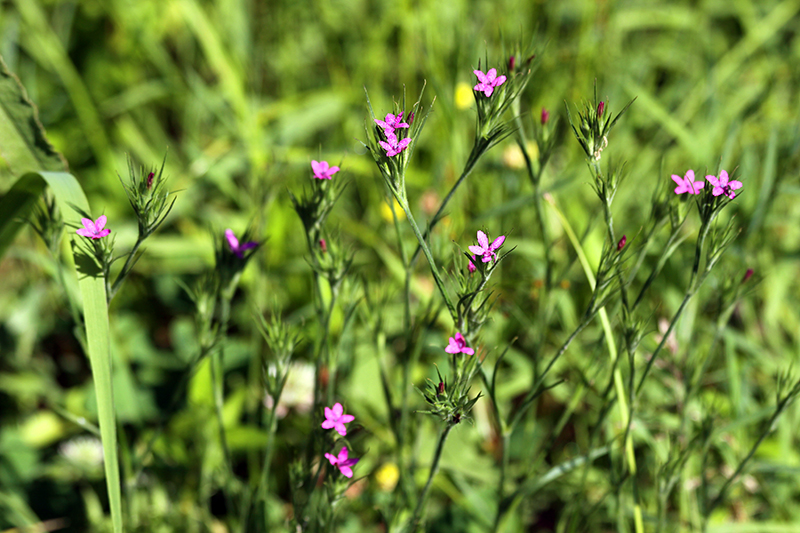
Dianthus armeria, or Deptford Pink, a relative of Sweet William
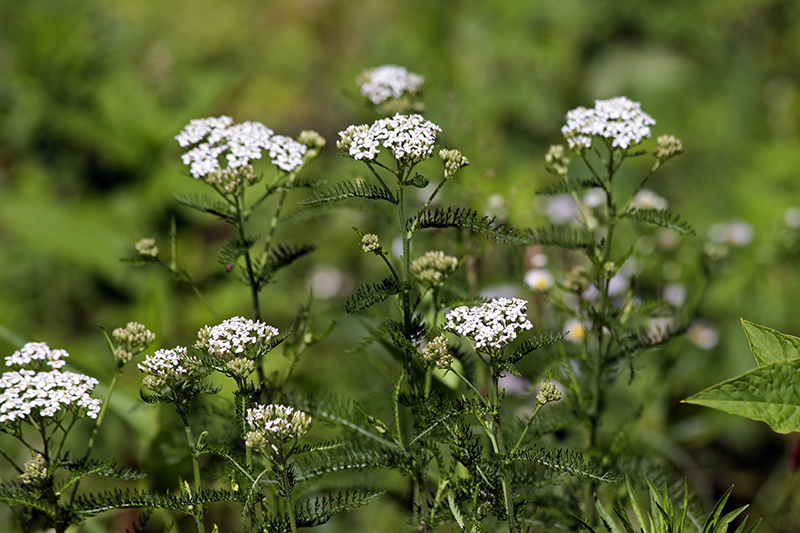
Achillea millefolium, common yarrow
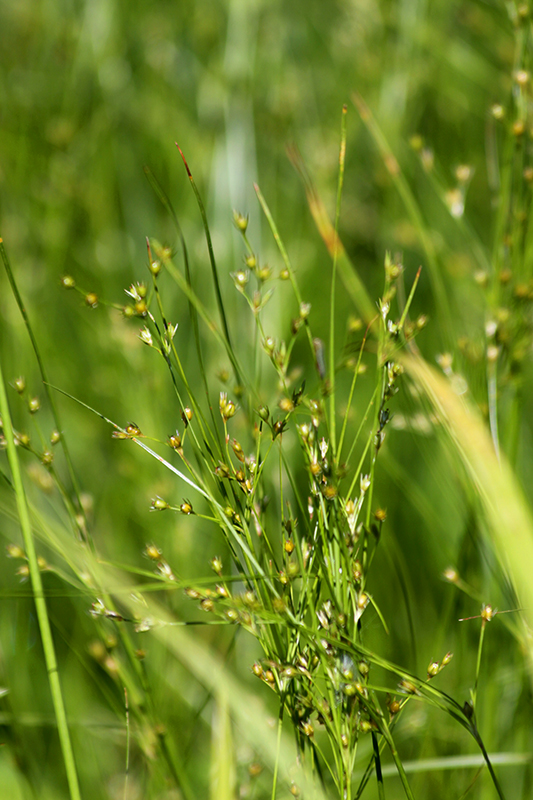
Some kind of very pretty, low-growing grass that reminds me of the “fiber optic grass” sold in nurseries. Any ideas what it is?
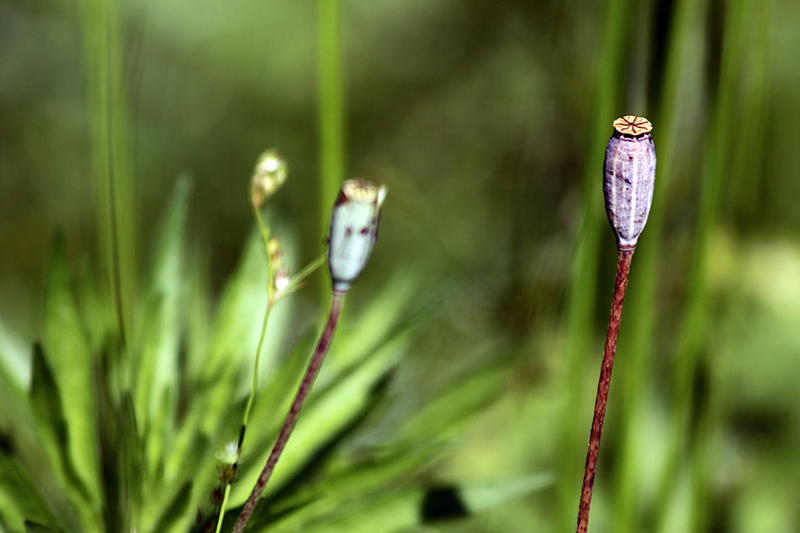
Papaver aculeatum (I think), orange poppy, gone to seed
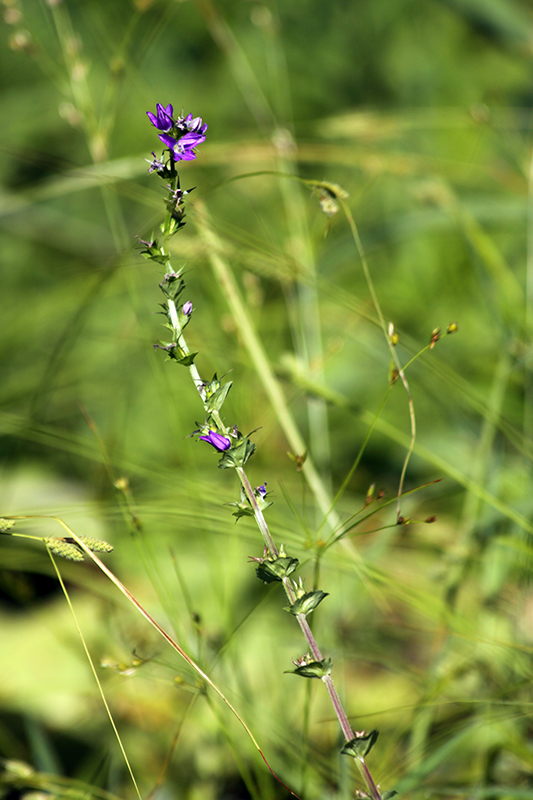
Triodanis perfoliata, Venus Looking Glass
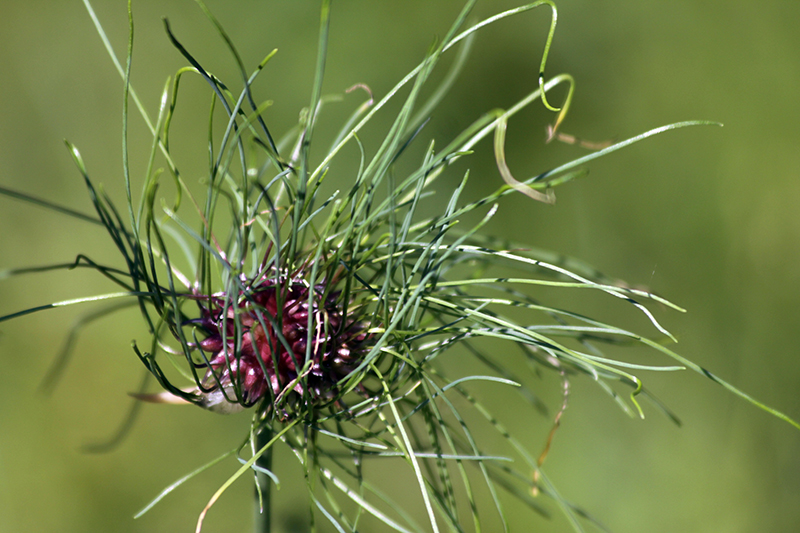
Wild onion, gone to seed
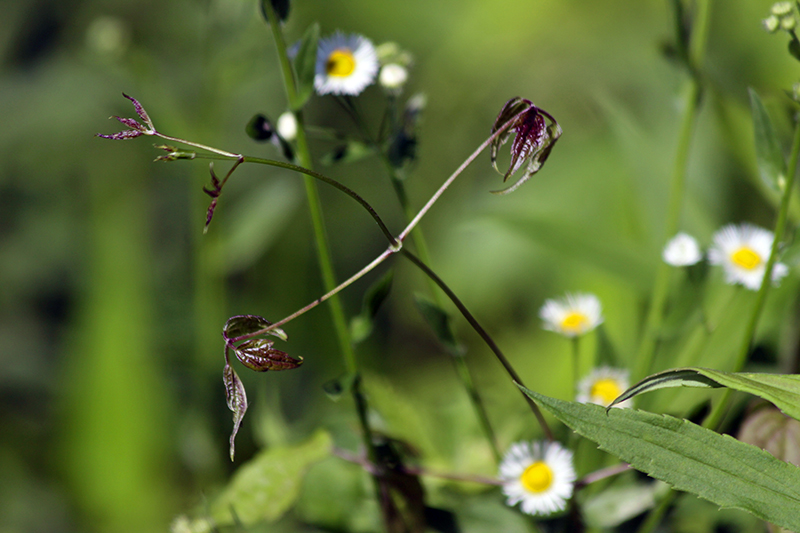
Parthenocissus quinquefolia, Virginia creeper, with Erigeron strigosus, Prairie Fleabane in the background
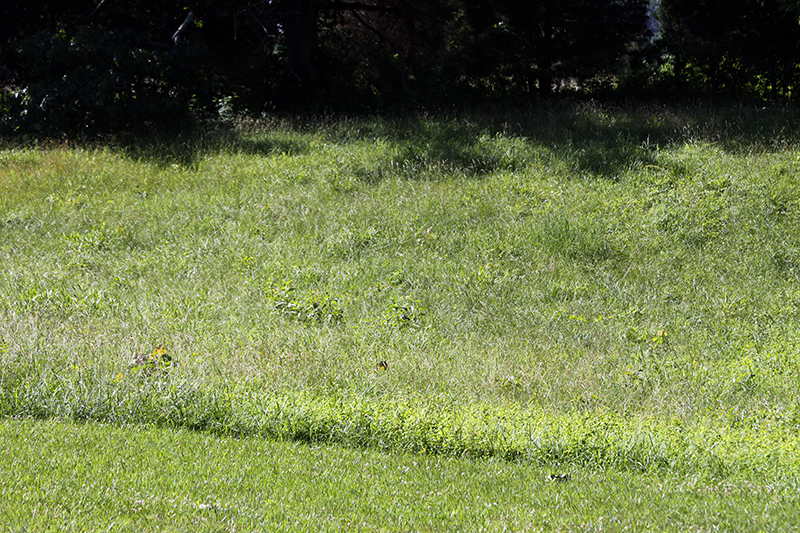
I look forward to watching this meadow progress through the summer, but in the meantime I find it so striking that the former hayfield, above, which I bush hog every now and then, is so much less botanically diverse than the new meadow, below, which sits just a few feet away. I am not sure if this is because the hayfield was created (how are hayfields created, anyway?) once upon a time to be primarily grasses, but I would have thought that by now it would have reverted to a more wild state. Perhaps the grass cover is too thick to allow other plants to germinate? Botanical succession—how plants reclaim and populate land, which come first, and how they create ideal conditions for each successive wave of new plants—fascinates me, and I am glad to have these uncultivated meadows that provide a wonderful laboratory to watch and learn from this process.

June 13th, 2014 §
The early June garden is shaping up nicely, and I am finally starting to see the effects of last year’s work as new additions bloom for the first time and older plants mature into proper specimens.
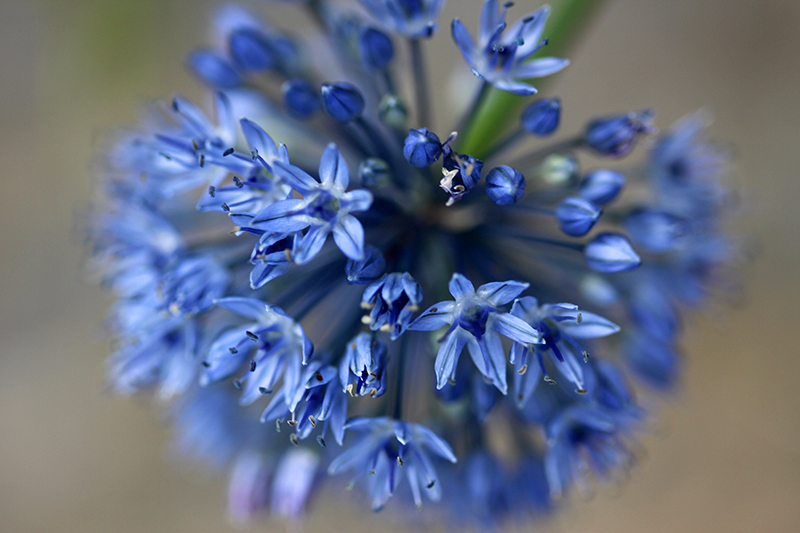
Allium caeruleum, a true blue color that’s hard to find among flowers of all kinds. I added a few to the garden last fall and they have bloomed with weak necks, which may be that they need time to beef up or they’re not happy with their locations. I hope it’s the former, as the color is awesome.

Deep red Asiatic lily, a big-box bag purchase that in four years has formed healthy, trouble-free (thus far), huge colonies in the garden.
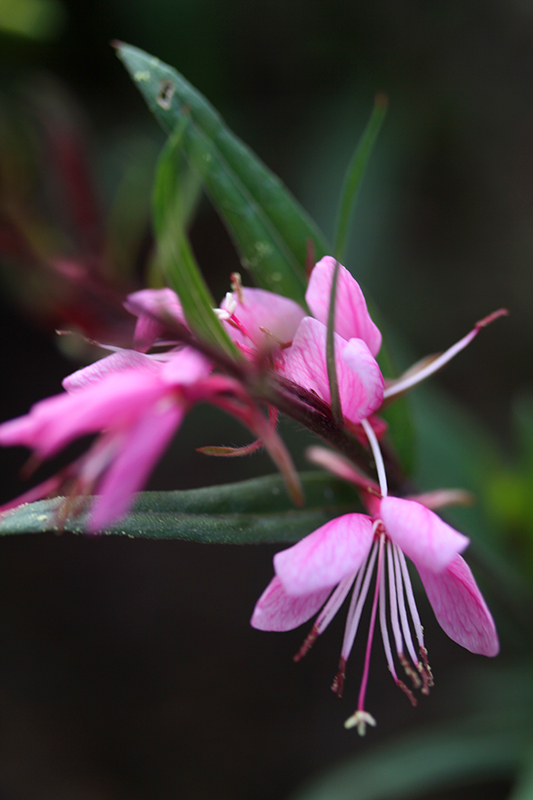
Pink gaura
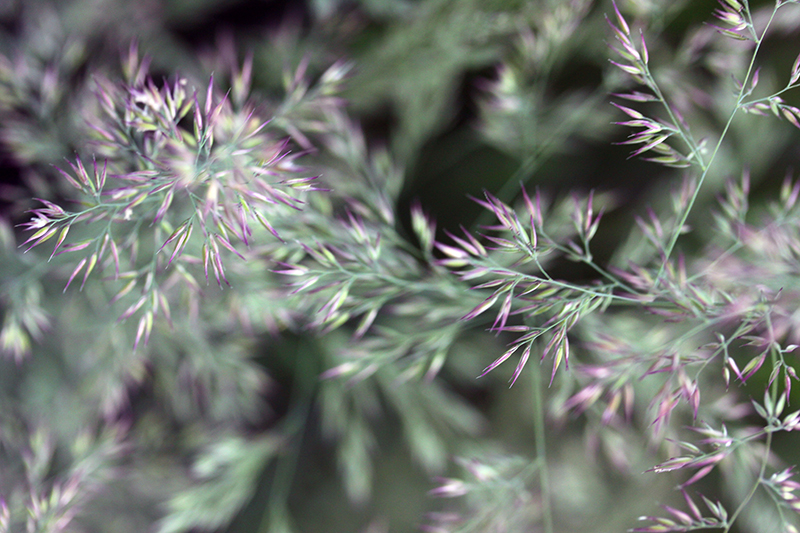
Ornamental feather reed grass, Calamagrostis acutiflora ‘Karl Foerster’ just heading up. Another standby that along with the lilies gives good height to the back of the June garden.

Geranium ‘Brookside’ bloom in front of Festuca glauca ‘Elijah Blue.’ I am really excited about these new hardy geraniums, or cranesbill, which I just put in all along the rock border of the garden. The idea is that they will spread and colonize these edges, and, I hope, keep the chickens from scratching all the mulch out of the garden into the yard. They’re gorgeous little plants, with blooms that are in life a bit bluer than in this picture.
My blue fescue has finally this year (I think it’s their third) matured into nice big plants that look like landscaping instead of errant pasture grass. I love how their color is almost an exact match for my porch floor.
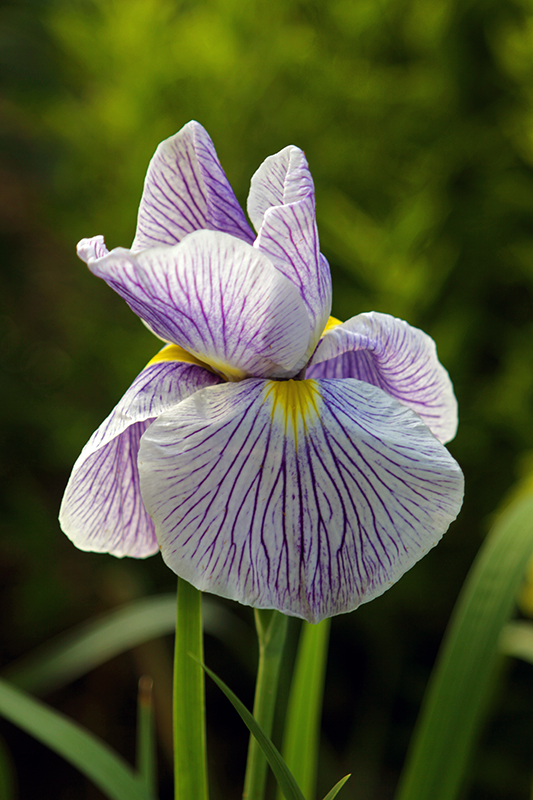
Iris ensata ‘Caprician Butterfly’. This Japanese iris goes through it’s bloom cycle so fast it’s hardly worth it. It spends one day blooming like this, then the next day the top petals drop down creating a flattened, donut-like bloom, and the next day the bloom is shriveled and brown. The bloom shape is not a look I love—I much prefer the upright flowers of the German and Siberian iris, but this plant was an experiment (aren’t they all!?) in growing irises that aren’t as susceptible to iris leaf spot as the German irises I removed from the garden.
June 5th, 2014 §
It’s finally time for one of my favorite gardening days of the year: redoing the front porch containers. Each spring, after the winter’s pansies poop out from rising temperatures, I get the instant gratification of putting together tiny minigardens to be appreciated up close each time I enter the house.
This year my mom and I discovered a fantastic greenhouse, Milmont, over the mountain in Stuarts Draft. Not only did they have varieties of plants that have been on my wish list for ages, and that I’d resigned myself to having to mail-order, they also had a thriving colony of purple martins living right near their greenhouses. Awesome, rare birds + spectacular, rare plants = pretty much my idea of heaven.

I came home with all the material for this summer’s container gardens and broke down the old arrangements, composting the spent pansies and then refreshing the pots with new soil and granular fertilizer. Then I got down to designing.
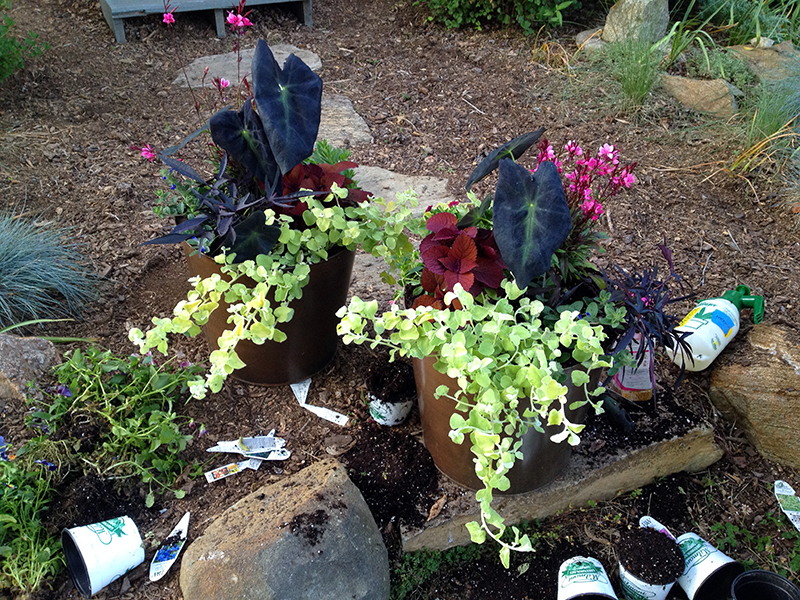
This year I wanted high-contrast color, dramatic leaf form, and to play around with some black foliage. To that end, the centerpiece of each container is a black Colocasia ‘Ilustris,’ and that tone is picked up again in black sweet potato vine, ‘Illusion Midnight Lace,’ which will spill over the edges. I always like to add rusty red-pink colors, because they are my favorite and tie into the color of my front door. For that I used Coleus ‘Colorblaze Keystone Kopper.’ I was really drawn to the icy, otherworldly green of Helichrysum petiolare ‘Lemon Licorice,’ to contrast with the black and brighten everything up. For color, I popped in a dwarf Gaura ‘Karalee Petite Pink,’ as well as Calibrachoa ‘Minifamous Double Magenta,’ which has bright pink flowers that look like tiny roses. And for a ringer, I added a shot of pure, bright blue with Evolvulus ‘Blue My Mind.’

The key to good containers, in addition to following the “thriller, spiller, filler” formula, is to stuff in way more plants than you think could fit. Yes, containers planted this fully require more attention with watering and feeding, but you get an instant, lush look. I already know that some of these plant will, if they’re happy, grow too large for these containers, so throughout the summer I will need to keep them trimmed and shaped up to continue looking nice. Not a hard task, and the added bonus is I can root the trimmings and make more plants!
The front porch, all dressed up for summer: the large evergreens below are some form of Chamaecyparis, which I’ve had for more than two years. They are very slow-growing and do okay in pots as long as they don’t dry out, but eventually they will need to be planted out in the yard. I refreshed their soil last year. The plant in the smallest pot is Sedum ‘October Daphne,’ which I cut back each winter for fresh regrowth.
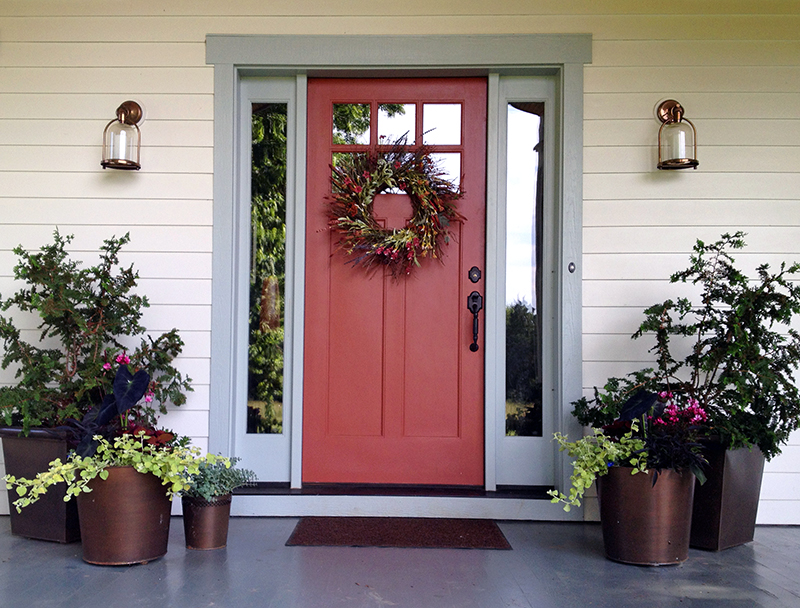
And a purple martin parting shot:

May 30th, 2014 §
For weeks I’ve been watching a little house wren sit on a tidy nest in a front-garden shrub. I’d found the nest with my spade raised to prise the bush from the ground for relocation. Four blue, brown-speckled eggs popped into view, tucked just inside.
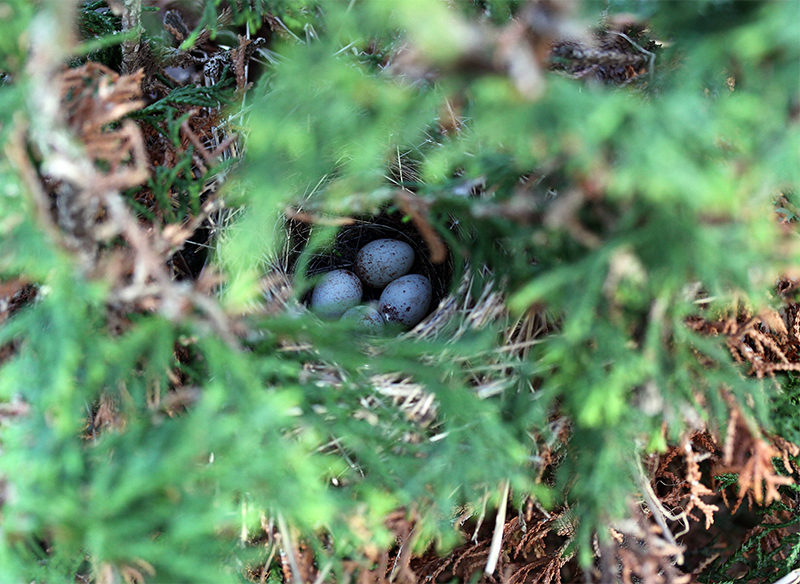
Obviously, landscaping was postponed, and each day I checked on the nest, always expecting the eggs to be gone. They were precariously sited in a bush not two feet off the ground, easy pickings for a snake or raccoon or possum. I considered surrounding the bush with some sort of barrier, but knew that the only thing that would keep a snake out was fine netting. I learned my lesson last summer when a large black snake got stuck and died in the netting I installed to protect the garden from the chickens. So I chose not to intervene with the nest.
Without any “help,” the eggs persisted, and two days ago the mother wren didn’t fly off the nest when I approached. She flattened her body in place, with only her brave eyes moving, and I knew her eggs had hatched.
Yesterday I went out to feed the chickens and saw Tucker bent over something in the grass. I knew that posture. Immediately I checked the nest, and it was empty.
I went back to where Tuck had been standing and searched the dewy clover. I found two little bodies, perfectly bloodless and still warm. I picked them both up, and they curled together in the palm of my hand as they must have in the nest. I almost felt their hearts beating against my skin, but knew it was only wishful thinking. Nearby the mother bird swooped and chattered, scolded and cried.
I buried the babies in a scrape of dirt, and went on with my chores, silent and avoiding eye contact with my dog. Of course I was sad but I had no right to be angry. I knew Tucker was only doing one of his jobs, hunting. A wild baby bird in an ill-positioned nest is to him no different than a rabbit flushed from the wellhouse or mole dug out of the pasture, and all are fair, encouraged game.
As I’d wrapped up the chicken chores I moved some flats of seedlings out of the shed into the rain. I glanced down and saw that my crepe myrtle, still in its gallon nursery pot, had leafed out by several inches from the base.
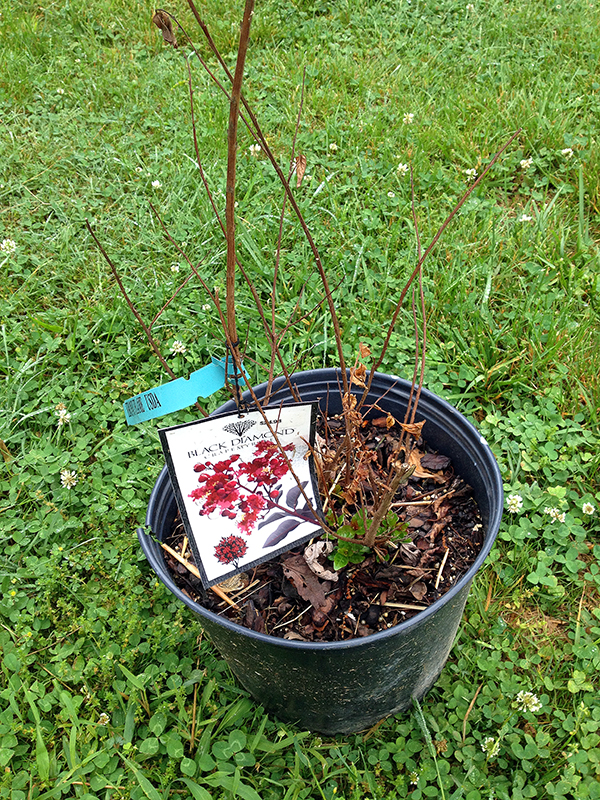
Seems reasonable until I tell you that I’d tortured this plant all last summer, letting it go bone dry and sunburned, as I prevaricated about where in the ground to stick it. And then summer became fall became our incredibly cold and snowy winter, all during which the pot of dead sticks sat unprotected outside of the wellhouse. I was disappointed in myself that I’d killed a perfectly good future tree by not being able to make a simple, timely decision, and just a few days ago I had accepted my crepe myrtle was toast and mentally pitched it on the compost pile.
But in that short interval between intention and action this forsaken plant had quietly, and on its own schedule, conveyed to me its plan to live.
Doing or not doing. Both are choices, and the joke of this choose-your-own-adventure is that we’re all just bumbling along. In a span of five minutes I got a perfect lesson in acting and not acting, and how each movement’s consequences can be both predictable and surprisingly unexpected.
I am going outside now to plant a crepe myrtle.
May 20th, 2014 §
This spring, the garden I’ve been most impressed with is the one I have spent the least amount of time thinking about and fussing over. Isn’t that the way it is with so many things—just set the ball rolling, get out of the way and wait to be unexpectedly amazed?

The strip of garden that runs along the east side of the house was an afterthought in many ways, even though it is the garden closest to the road and should be a showpiece. When the house was built I threw some shrubs in to hold the soil on the bank—a few doublefile viburnums and some dwarf oakleaf hydrangeas, two of my favorite shrubs. Then last year I extended the garden by building the rock wall, and added some gift irises and a few more little plants as I bought them. Because there are no evergreens it looks pretty bare in winter, but this spring the bank erupted in what turned out, this year, to be a quite nice combination of bloom, leaf shape, and color variation. It’s a very old-fashioned feeling garden, with classic plants that one might find around Grandma’s country cottage.
The first to bloom are the the daffodils in late winter, and I am happy to see that their decaying foliage will soon be hid by the new growth coming in on the shrubs, just as it should be. I particularly love the variegated Solomon’s Seal (Polygonatum odoratum var. pluriflorum ‘Variegatum’) at lower right, below, with its white bell-like blooms and sturdy foliage that remains attractive all season.

The front corner is anchored by these nice catmints (Nepeta ‘Walker’s Low’), new last year, that continue the lavender bloom color begun by the iris.
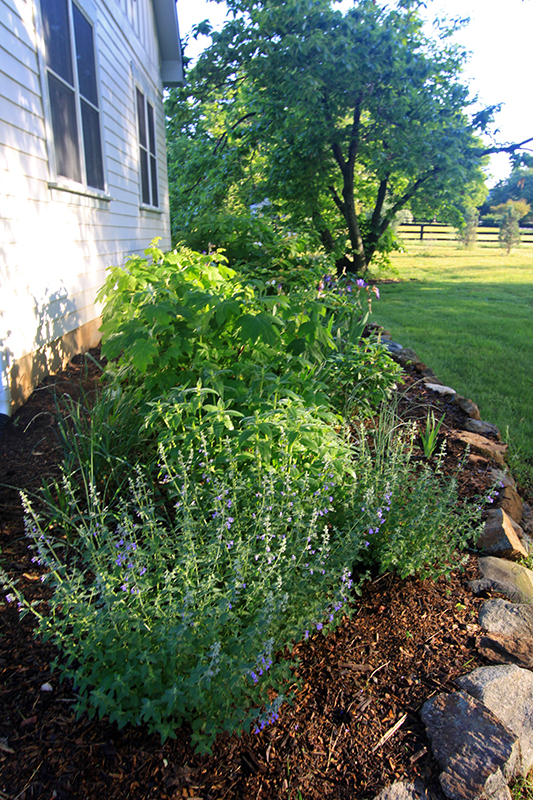
The viburnums have finished their bloom, and the irises are soon to say goodbye. I have a few peonies, planted last spring to test if they liked this location, that are budding now. I will see how they look when they bloom, and if I like the effect I will add more peonies to continue the colorful blooms a few more weeks. That should take me until hydrangea time…but after that I will have to figure out what to add to maintain interest here through the dog days of summer until the hydrangeas change into their red leafed costumes for a fall display.
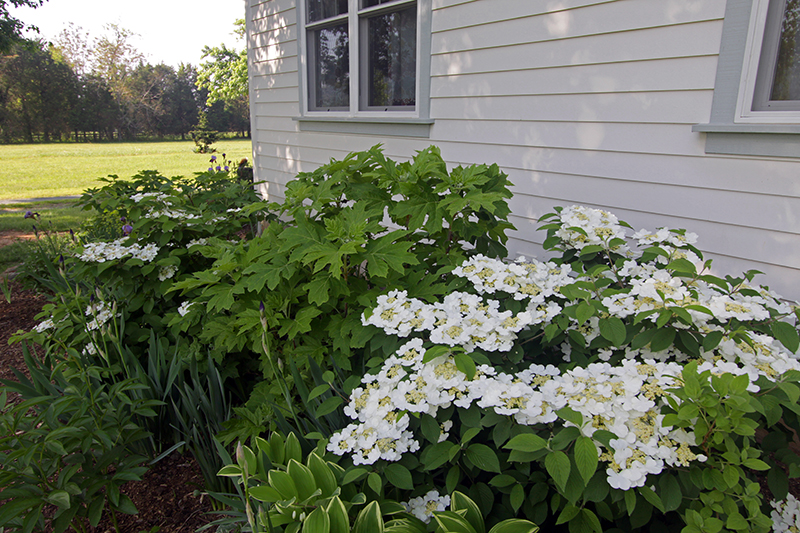
Next fall I will divide the Solomon’s Seal to spread bits of it through the whole garden, and to move it more forward of the shrubs. If I can find something low and pretty all season (maybe some kind of Ajuga, which has purple blooms at the same time as the iris?) to go right along the top of the rock wall, this will really shape up nicely—almost as if I planned it!
And then just when it looks awesome there’s a good chance the shrubs will have grown too large and it will be time to pull them out and start over!
As a way of explaining some of my happiness with this garden’s progress, check out what it looked like just a bit more than a year ago:
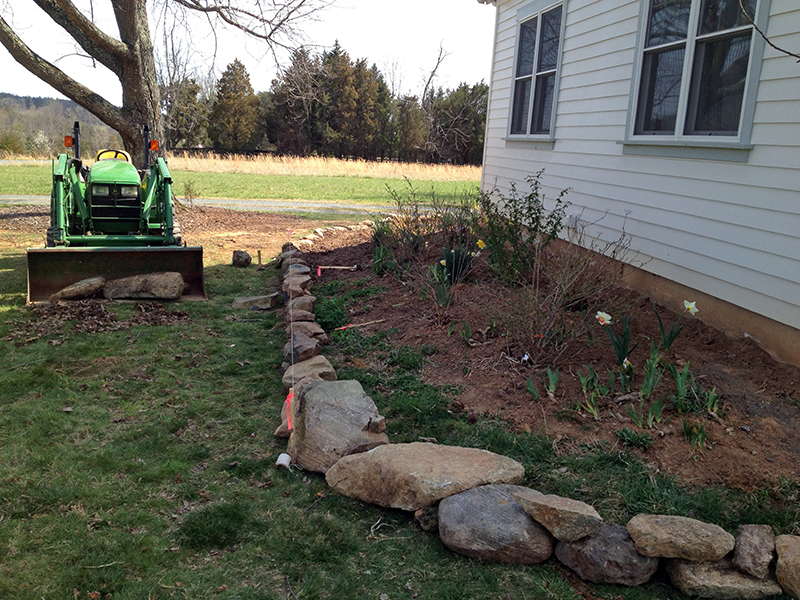
Seeing this photo it’s clear to me that I did the right thing by extending the garden to lessen the slope away from the house, which was making it hard to keep enough water on the shrubs to make them happy, and all the plants responded really well to the back-fill addition of forest-dug compost and a thick blanket of mulch. The border is deep enough (10 feet) that I am able to enjoy the show from inside the house, looking out through the windows, which is an aspect that is so enjoyable but that few consider when creating foundation plantings.
May 8th, 2014 §
The day I buy the vegetables that will be the year’s summer garden is always a happy day. The first smell of crushed tomato leaves jolts awake some deeply-buried, winter-weary brain synapses and floods my entire body with relief and joy. When the tomatoes come out, winter’s really over. We made it through another one.
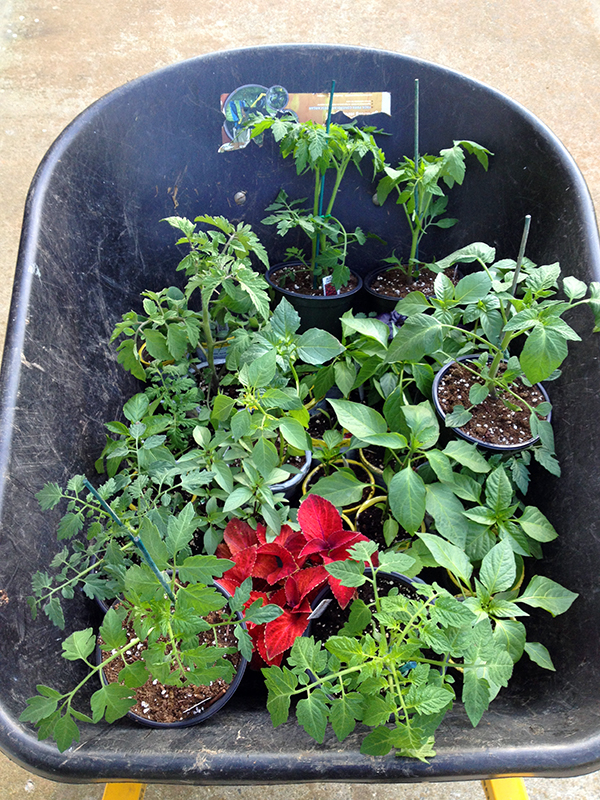
It’s hard to imagine it today when an entire garden’s worth of veg fits in the wheelbarrow, but in a couple of months these small plants will be pumping out enough produce to keep my family and me in good supply, with extra left over for freezing or friends.

That is, of course, if I am lucky and smart in my battle against innumerable insects, diseases, and weather. Growing pesticide-free food, at least in central Virginia, is a nonstop intellectual challenge, a chess game of anticipation and reaction. It’s never easy, but I suppose that’s why I keep doing it.
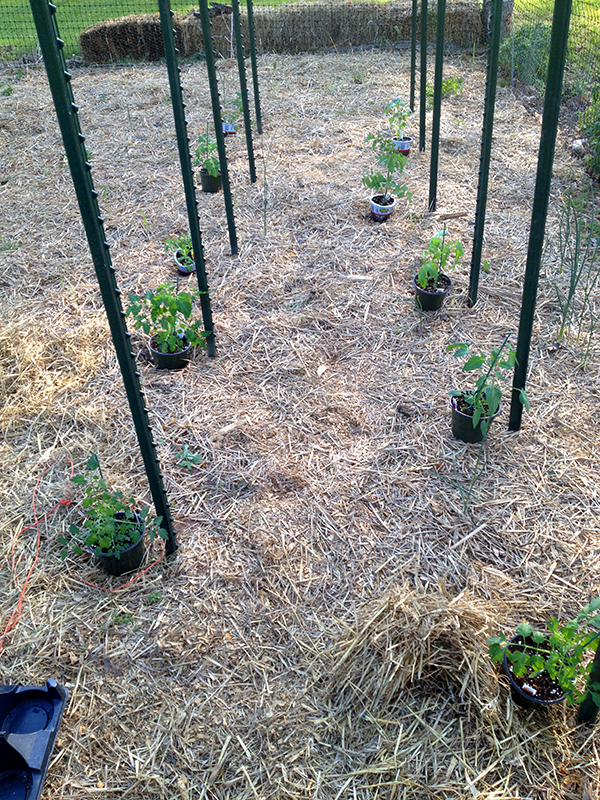
Let the games begin!





















































